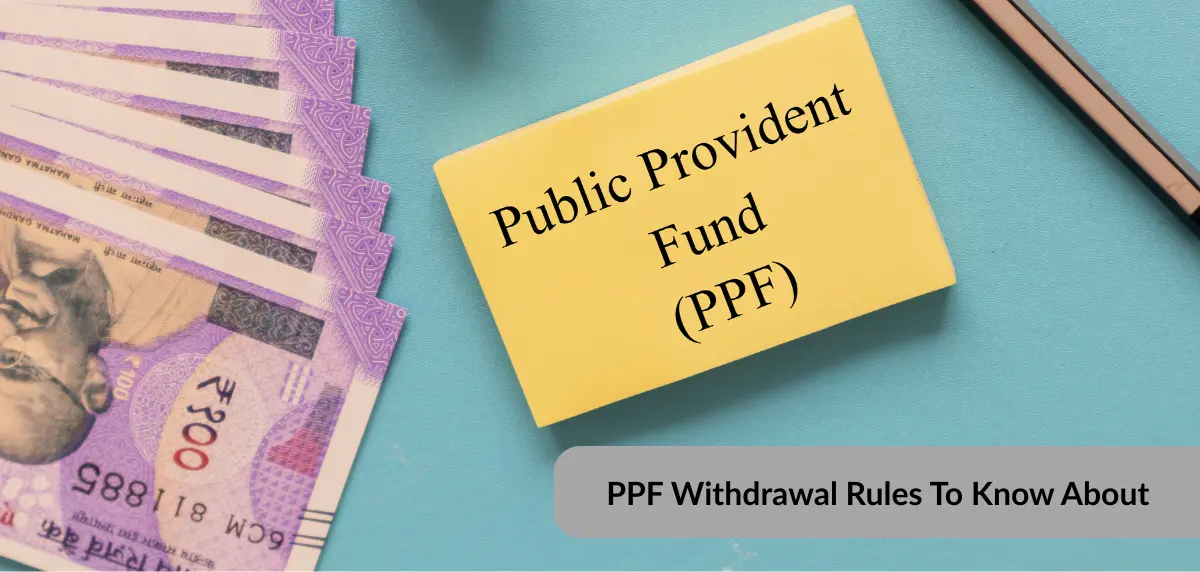The Public Provident Fund (PPF) is one of the most trusted long-term savings schemes in India. Backed by the government, it not only offers attractive interest rates but also tax benefits under Section 80C. While PPF is an easy-to-understand scheme and opening an account is simple, understanding the rules around withdrawal of PPF funds is essential. The PPF withdrawal rules can vary on the basis of whether you are planning a partial withdrawal, a premature one, or want funds after your account has completed the 15-year lock-in period.
Understanding PPF Withdrawal Rules
The government has laid out specific rules that govern when and how you can withdraw funds from your PPF account.
To begin with, there are three main types of PPF withdrawal scenarios:
Let’s break each of them down in detail.
Partial Withdrawal Rules
You can make partial withdrawals from your PPF account only after completing five financial years from the date of account opening. One of the major PPF partial withdrawal rules to keep in mind is that the maximum you can withdraw is 50% of the balance at the end of the fourth financial year preceding the year of withdrawal.
Partial withdrawals are tax-free, as PPF comes under the E-E-E (exempt-exempt-exempt) category. A partial withdrawal is ideal for situations where you need access to funds without closing the account or sacrificing its long-term benefits. **
Premature Withdrawal Rules (Total Corpus)
Premature closure and full withdrawal from a PPF account are allowed only after five years. However, there are specific PPF account withdrawal rules to consider. One can make a premature withdrawal of the total corpus only under specific conditions, such as:
Premature withdrawal also leads to a penalty in the form of a reduction of the rate of interest by 1% from the rate which was earlier applicable. Hence, one must keep the PPF rules of withdrawal in mind and use the feature only for the specified emergencies.
Withdrawal After 15 Years (Maturity)
After the PPF account completes its 15-year tenure, you are free to withdraw the entire balance, including principal and interest, without any penalties or deductions. There are no specific PPF withdrawal rules applicable at this juncture.
Here are your options after maturity:
PPF Withdrawal Rules After Extension
While one can enjoy smoother withdrawals after extension, there are still some PPF withdrawal rules that need to be factored in.
If you choose to extend your PPF account after the initial 15-year maturity:
The relaxed rules of PPF withdrawal after maturity allow investors to keep earning interest even while giving them access to a portion of their funds for retirement or other essential needs.
Tax Benefits on PPF Withdrawals**
PPF enjoys Exempt-Exempt-Exempt (EEE) status, which means:
However, a new rule applies from April 1, 2021:
If the total contribution made by an employee exceeds ₹2.5 lakh in a year across provident fund accounts (including PPF), the interest earned on the excess amount will be taxable. For government employees whose employers do not contribute to their PF accounts, the limit extends to ₹5 lakhs.
This rule may not affect most individual PPF account holders, as the annual contribution cap for PPF itself is ₹1.5 lakh.
PPF Withdrawal Summary Table
The Public Provident Fund withdrawal rules can be summarised briefly in the following table:
Withdrawal Type
| Eligibility
| Limit
| Penalty/Condition
|
|---|
Partial Withdrawal
| After 5 years.
| 50% of the balance (as per rules).
| No penalty.
|
Premature Withdrawal
| After 5 years (with a valid reason).
| Full withdrawal allowed.
| 1% reduction in interest rate; conditions to be met for withdrawal.
|
Withdrawal After 15 Years
| Upon maturity.
| Full balance.
| No penalty, fully tax-exempt.
|
Withdrawal After Extension
| After extending for 5 years.
| Up to 60% of the balance over 5 years.
| One withdrawal allowed per financial year.
|
Why is PPF a Solid Savings Option
PPF is a solid savings-cum-investment option for several reasons.
One reason PPF is widely trusted is that it is government-backed, which means your capital and interest are safe from market risks. It is perfect for individuals who prefer steady growth without the volatility of stocks or mutual funds. What’s more, the fixed interest rate, which is compounded annually, makes it easier to project future returns. You can use a PPF calculator to estimate the maturity amount based on your annual contributions and tenure.
Suitable Alongside Other Options
PPF can be a good addition to a balanced portfolio that contains several other instruments, such as ULIPs, NPS, and equity mutual funds.
When it comes to NPS vs PPF in particular, remember that NPS is partly market-linked. It is better suited for those aiming for higher returns with a longer retirement horizon. PPF, however, is ideal if you want more control, tax-free returns, and guaranteed security.
Another comparison that many may have in mind is - EPF vs PPF. Note that EPF is tied to your employment, while PPF is completely independent. So even if you are self-employed, PPF remains a viable and flexible savings option.
PPF allows partial withdrawals and account extensions, which gives you control without completely locking in your money. When used strategically, it can become a core part of smart financial planning.
In summary, whether you are planning for retirement, your child’s future, or just building long-term wealth, PPF offers the perfect mix of safety, growth, and flexibility. By understanding the detailed PPF withdrawal rules, you can make the most of your PPF account without incurring penalties or losing out on returns. Always plan withdrawals wisely to protect your financial future.
** Tax exemptions are as per applicable tax laws from time to time.





















